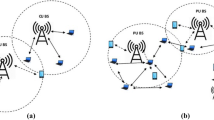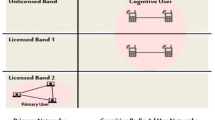Abstract
Opportunistic spectrum access using cognitive radio technology enables exploring vacant licensed spectrum bands and thereby improving the spectrum utilization. However, it will have a significant impact on upper layer performance like routing as the reliable knowledge of topology and channel statistics are not available, especially in Mobile Cognitive Radio Ad hoc Network (MCRAN). To address specific requirements of MCRAN, this paper is proposing online opportunistic routing algorithm using multi-agent reinforcement learning. The proposed routing scheme jointly addresses, link and relay selection based on transmission success probabilities. This sophisticated learning mechanism successfully explores opportunities in partially observable and non-stationary environment of MCRAN. Simulation results show the effectiveness of this algorithm.









Similar content being viewed by others
References
Akyildiz IF et al (2006) Next generation/dynamic spectrum access/cognitive radio wireless networks: a survey. Elsevier Int J Comput Netw 50:2127–2159
Sengupta S, Subbalakshmi KP (2013) Open research issues in multi-hop cognitive radio networks. IEEE Commun Mag 51(4):168–176
Pan M et al (2012) Spectrum harvesting and sharing in multi-hop CRNs under uncertain spectrum supply. IEEE J Sel Areas Commun 30(2):369–378
Thomas Hou Y et al (2008) Spectrum sharing for multi-hop networking with cognitive radios. IEEE J Sel Areas Commun 26(1):146–155
Huisheng M et al. (2008) Spectrum aware routing for multi-hop cognitive radio networks with a single transceiver. 3rd International Conference on Cognitive Radio Oriented Wireless Networks and Communications CrownCom 2008. 1-6, doi:10.1109/CROWNCOM.2008.4562509
Badoi CI et al. (2010) IPSAG: an IP spectrum aware geographic routing algorithm proposal for multi-hop cognitive radio networks. 8th International Conference on Communications (COMM), 491–496. doi: 10.1109/ICCOMM.2010.5509020
Zeeshan M et al. (2010) Backup channel and cooperative channel switching on-demand routing protocol for multi-hop cognitive radio ad hoc networks (BCCCS). 6th International Conference on Emerging Technologies (ICET 2010), 394–399
Cesana M et al (2011) Routing in cognitive radio networks: challenges and solutions. Elsevier Int J Ad Hoc Netw 9(3):228–248
Lee J-J, Lim J (2014) Cognitive routing for multi-hop mobile cognitive radio ad hoc networks. J Commun Netw 16(2):155–161
Royer EM, Toh CK (1999) A review of current routing protocols for ad hoc mobile wireless networks. IEEE pers Commun 6(2):46–55
How KC et al (2011) Routing and QoS provisioning in cognitive radio networks. Elsevier Int J Comput Netw 55(1):330–342
Di Felice M et al (2010) End-to-end protocol for cognitive radio ad hoc networks: an evaluation study. Int J Perform Eval 68(9):859–875
Huang X-L et al (2011) Stability-capacity-adaptive routing for high-mobility multihop cognitive radio networks. IEEE Trans Veh Technol 60(6):2714–2729
Cacciapuoti AS et al (2012) Reactive routing for mobile cognitive radio ad hoc networks. Elsevier J Ad Hoc Netw 10:803–815
Liu Y et al (2012) Spectrum-aware opportunistic routing in multi-hop cognitive radio networks. IEEE J Sel Areas Commun 30(10):1958–1968
Ding L et al (2010) Cross-layer routing and dynamic spectrum allocation in cognitive radio ad hoc network. IEEE Trans Veh Technol 59(4):1969–1979
Chunsheng X et al. (2005) A novel layered graph model for topology formation and routing in dynamic spectrum access networks. First IEEE International Symposium on New Frontiers in Dynamic Spectrum Access Networks DySPAN,308–317 doi:10.1109/ DYSPAN. 2005.1542647
Guan Q et al (2010) Prediction-based topology control and routing in cognitive radio mobile ad hoc networks. IEEE Trans Veh Technol 59(9):4443–4452
Chowdhury KR, Akyildiz IF (2011) CRP: a routing protocol for cognitive radio ad hoc networks. IEEE J Sel Areas Commun 29(4):794–804
Bhorkar AA et al (2012) Adaptive opportunistic routing for wireless ad hoc networks. IEEE/ACM Trans Netw 20(1):243–256
Xia B et al. (2009) Reinforcement learning based spectrum-aware routing in multi-hop cognitive radio networks. 4th IEEE International conference on Cognitive Radio Oriented Wireless Networks and Communications CROWNCOM 1–5
Wu C et al (2010) Spectrum management of cognitive radio using multi-agent reinforcement learning. 9th Int. Conf. on Autonomous Agents and Multiagent Systems (AAMAS 2010), Toronto
Abedi O, Berangi R (2013) Mobility assisted spectrum aware routing protocol for cognitive radio ad hoc networks. Journal of Zhejiang University-SCIENCE C (Computers & Electronics) 14(11): 873–886 ISSN 1869–1951; ISSN 1869-196X (Online)www.zju.edu.cn/jzus; www.springerlink.com
Oo MZ, Othman M (2012) Analytical studies of interaction between mobility models and single-multi paths routing protocols in mobile ad hoc networks. Springer Wirel Personal Commun 64(2):379–402
Ariyakhajorn J et al. (2006) A comparative study of random waypoint and gauss-markov mobility models in the performance evaluation of MANET. Int. Symposium on Communications and Information Technologies ISCIT pp. 894,899 Oct. 18–20
Liu B-H et al (2011) Message-efficient locatiodiction for mobile objects in wireless sensor networks using a maximum likelihood technique. IEEE Trans Comput 60(6):865–878
Sharma M et al. (2007) Channel selection under interference temperature model in multi-hop cognitive mesh networks. 2nd IEEE International Symposium on New Frontiers in Dynamic Spectrum Access Networks DySPAN doi: 10.1109/DYSPAN.2007.25
Wei-bing LIU, Xian-jia WANG (2009) Dynamic decision model in evolutionary games based on reinforcement learning. Int J Syst Eng-Theory Pract 2(3):28–33
Duana Y et al (2007) Application of reinforcement learning in robot soccer. Eng Appl Artif Intell 20:936–950
Huang Z et al (2011) Reinforcement learning based resource allocation in business process management. Int J Data Knowl Eng 70:127–145
Usaha W, Barria JA (2007) Reinforcement learning for resource allocation in LEO satellite networks. IEEE Trans Syst, Man Cybern-Part B: Cybern 37(3):515–527
EI-Alfy EI-S et al (2006) A learning approach for prioritized handoff channel allocation in mobile multimedia network. IEEE Trans Wirel Commun 5(7):1651–1660
Nie J, Haykin S (1999) A dynamic channel assignment policy through Q-learning. IEEE Trans Neural Netw 10(6):1443–1455
Kaebling LP et al (1996) Reinforcement learning: a survey. J Artif Intell Res 4:237–285
Sharma R, Gopal M (2010) Synergizing reinforcement learning and game theory-a new direction for control. Elsevier Int J Appl Soft Comput 10:675–688
Sutton RS, Barto AG (1998) Reinforcement learning: an introduction. MIT Press, Cambridge
Acknowledgments
This work is partially supported by the Research Promotion Scheme of All India Council for Technical Education, India, Grant No. 20/AICTE/RIFD/RPS(POLICY-III)78/2013-14. The author would like to thank the reviewers for their helpful and constructive comments.
Author information
Authors and Affiliations
Corresponding author
Rights and permissions
About this article
Cite this article
Barve, S.S., Kulkarni, P. Multi-Agent Reinforcement Learning Based Opportunistic Routing and Channel Assignment for Mobile Cognitive Radio Ad Hoc Network. Mobile Netw Appl 19, 720–730 (2014). https://doi.org/10.1007/s11036-014-0551-6
Published:
Issue Date:
DOI: https://doi.org/10.1007/s11036-014-0551-6




